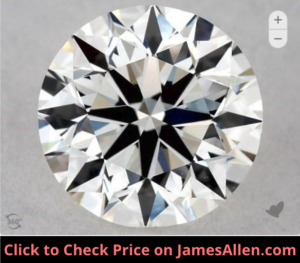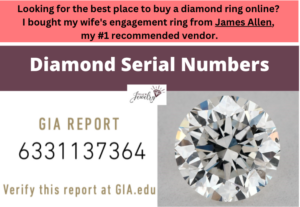
Buying a quality diamond is often an expensive purchase, so it’s worth performing due diligence to ensure you’re getting what you pay for.
Diamonds are generally priced based on how they score across the Gemological Institute of American (GIA) scale’s four primary factors: cut, clarity, color, and carat.
But how do you know those grades correspond with that particular diamond, and whether it’s real or lab-grown?
That’s where diamond serial numbers come into play.
Which Diamonds Have Serial Numbers?
Diamonds graded by the GIA and other certifying organizations have serial numbers to prove their authenticity.
The number on the diamond corresponds with the certificate, so you know it’s a match.
It’s engraved on the girdle of the diamond, which is the area of the stone that separates the top from the bottom. You’ll likely need a loupe with 10x magnification to read it.
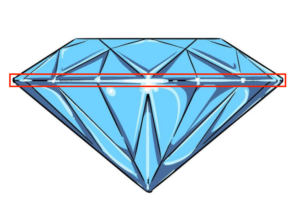
You might worry having a serial number on the diamond impacts its quality or performance, but the opposite is true.
The serial number is laser-inscribed on the diamond, so it can’t be seen with the naked eye and is so small it doesn’t affect the diamond’s light performance or sparkle in any way.
For example, Whiteflash, an online jewelry retailer, provides the GIA report for their diamonds. This 1.13-carat round cut diamond has a report that includes its serial number: 6332456246.
The number is inscribed on its girdle, so you know the report matches that diamond.
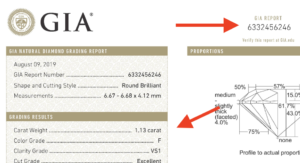
You can be confident it scores the following grades for the four Cs:
- 1.13 carats
- Excellent cut
- F color
- VS1 clarity
No other diamond has that serial number.
Other certifying institutions such as the EGL have a similar system, where diamonds are given a serial number that matches its report.
How to Look Up a Diamond’s Serial Number and Report
Whether you’re buying a diamond from a reputable jeweler or secondhand, you can look up a diamond’s report based on its serial number.
If it’s a GIA diamond, visit this page on their website to check a report. To show you how it works, I’ll walk through a real example.
Let’s say you’re exploring the round-cut diamond pictured below.
At the top of its GIA report, you’ll find the serial number, which is 2427141336.
Enter that number on the GIA’s report check page, and it’ll take you to its diamond grading report.
From there, you can confirm the report matches the one on the jeweler’s website.
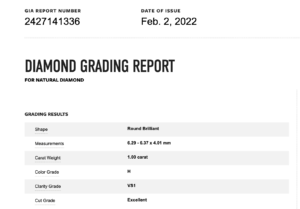
In this case, I confirmed it’s a one-carat diamond with an H color and VS1 clarity grade. Its cut is excellent.
I went through the same process with this diamond graded by the American Gem Society (AGS), and the report is below.
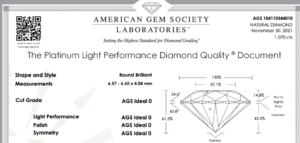
To do the same with your diamond, visit the AGS’s website and enter the serial number. The report should match the one you’re viewing from the jeweler.
This process works the same with most organizations that certify the quality of diamonds.
Why are Serial Numbers Important?
Diamond serial numbers are important for three reasons.
First, you can be confident in your diamond’s quality. Because they’re such an expensive purchase, and the average consumer isn’t an expert in diamond quality, the jewelry industry is filled with fraudulent claims.
By presenting a diamond as a better cut, clarity, color, and carat than it is, the seller can charge more.
For example, the price of a diamond generally increases 10-15 percent for every step up the color and clarity scale.
This can amount to hundreds or thousands of dollars if you buy a diamond thinking it’s a VVS1 clarity grade, but it actually earned VS2.
Additionally, it verifies whether it’s a natural or lab-grown diamond. The two appear identical, so you need a report to determine its authenticity.
Similar to its color, cut, and clarity grades, you’ll overpay for a diamond if you thought it was earth-mined when it was actually grown in a lab.
Without a serial number and the corresponding report for the GIA or another credible grading institution, it’s difficult to tell the true quality of a diamond.
Secondly, when you purchase a diamond, your name can be listed with the certificate.
That means if the diamond is lost, you can potentially recover it if the person who finds it goes through the process of finding the serial number and contacting its owner. Or if it’s stolen, it’s a way for you to prove ownership if it’s ever recovered.
Thirdly, the serial number ensures potential buyers of its value if you ever decide to sell your diamond.
Just like you wanted to know the diamond’s quality when you first bought it, you need to convince its next owner it’s legitimate.
By having the serial number and certificate from the GIA, the buyer will be convinced of its true value.
Can You Resell a Diamond Without a Serial Number and Certificate?
It’s possible to resell a diamond with a serial number and certificate, but it’ll be more difficult to capture its full value. That’s because the buyer may not take your word that it’s of a certain cut, clarity, color, or carat.
The buyer will likely go through an extensive evaluation process that includes testing if the diamond is real and having it graded by a professional jeweler.
It can cost between $150 and $300 to have a diamond graded by a certified gemologist.
While not having a serial number on your diamond doesn’t mean it won’t sell, if you ever do plan to sell it, have it certified by the GIA and hold on to certifying documents.
Conclusion
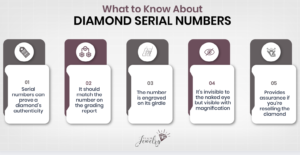
Diamonds have serial numbers to prove a particular diamond matches its certificate of authenticity. Without it, someone could claim the diamond is of higher quality than it really is.
To safeguard your purchase, you should always buy a diamond with a serial number and matching certificate from a credible grading institution such as the GIA.
Even when you’re browsing diamonds from trusted jewelers online or in person, verify it’s serial number and report on the GIA’s website.
No one will see the serial number with the naked eye, and it won’t impact light performance. So there are only upsides to having a diamond with a serial number.

Jacob Clarke
Jacob Clarke is the founder of TeachJewelry.com.
He earned an Applied Jewelry Professional Diploma from the Gemological Institute of America (GIA) and now brings you essential information about diamonds, settings, and more.
Jacob has consulted with leading jewelry brands, and his work has been cited in Clean Origin, Diamond Nexus and industry publications.
He's also a member of the International Gem Society.
He enjoys discussing jewelry with readers, so contact him with any questions at jacob.clarke@teachjewelry.com.

